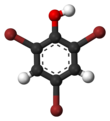| |||
| Names | |||
|---|---|---|---|
| Preferred IUPAC name
2,4,6-Tribromophenol | |||
| Other names
Tribromophenol; 2,4,6-TBP; TBP
| |||
| Identifiers | |||
3D model (JSmol)
|
|||
| ChEBI | |||
| ChEMBL | |||
| ChemSpider | |||
| DrugBank | |||
| ECHA InfoCard | 100.003.890 | ||
| KEGG | |||
PubChem CID
|
|||
| UNII | |||
CompTox Dashboard (EPA)
|
|||
| |||
| |||
| Properties | |||
| C6H3Br3O | |||
| Molar mass | 330.801 g·mol−1 | ||
| Appearance | White needles or prisms[1] | ||
| Melting point | 95.5 °C (203.9 °F; 368.6 K)[1] | ||
| Boiling point | 244 °C (471 °F; 517 K)[3] 286 °C[1] | ||
| Slightly soluble[1] 59-61 mg/L[2] | |||
| Hazards | |||
| GHS labelling: | |||
  [4] [4]
| |||
| NFPA 704 (fire diamond) | |||
| Lethal dose or concentration (LD, LC): | |||
LD50 (median dose)
|
2000 mg/kg (rat, oral)[1] | ||
Except where otherwise noted, data are given for materials in their standard state (at 25 °C [77 °F], 100 kPa).
| |||
2,4,6-Tribromophenol (TBP) is a brominated derivative of phenol. It is used as a fungicide, as a wood preservative, and an intermediate in the preparation of flame retardants.
- ^ a b c d e "3851: Tribromophenol" in Gardner's Commercially Important Chemicals: Synonyms, Trade Names, and Properties, G. W. A. Milne (Editor), ISBN 978-0-471-73518-2, page 632
- ^ Concise International Chemical Assessment Document 66: 2,4,6-Tribromophenol and Other Simple Brominated Phenols, International Programme on Chemical Safety
- ^ Merck Index, 11th Edition, 9526
- ^ Sigma-Aldrich Co., 2,4,6-Tribromophenol. Retrieved on 2015-02-19.


